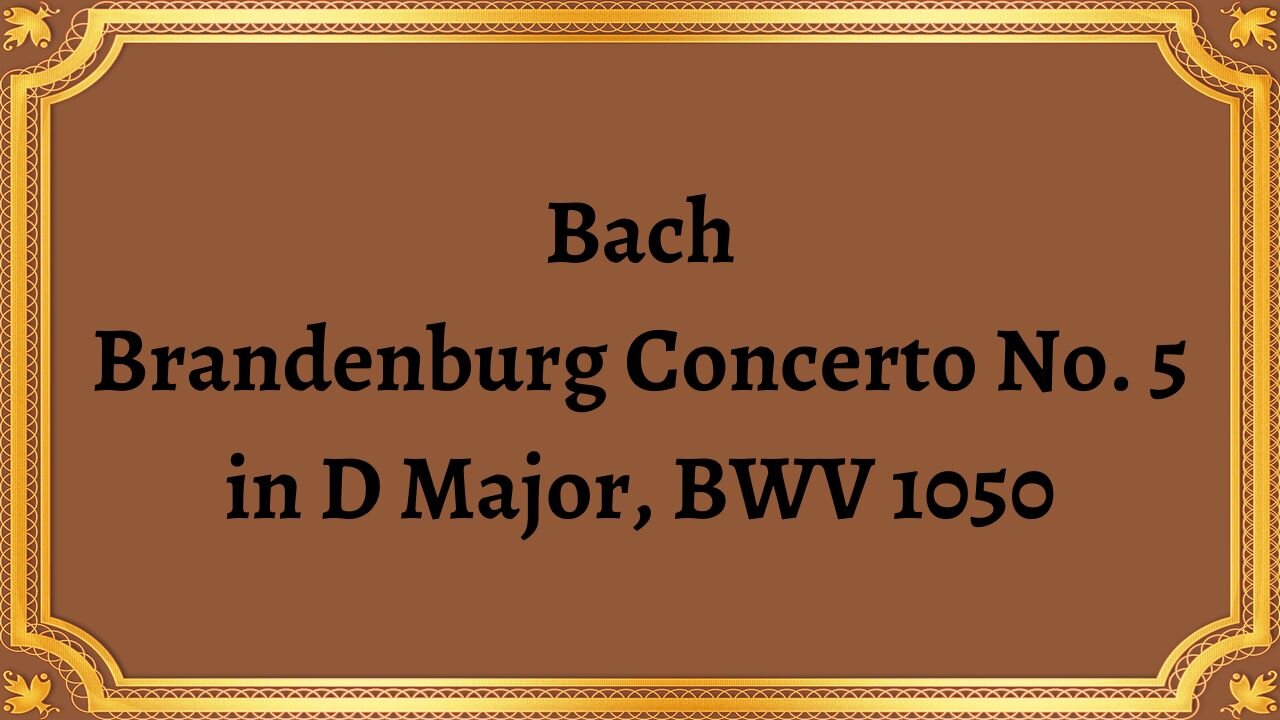Premium Only Content

Bach Brandenburg Concerto No. 5 in D Major, BWV 1050
#classical_music #Bach #Brandenburg_Concerto
Bach's Brandenburg Concerto No. 5 in D Major, BWV 1050, is a masterwork of the Baroque era and a cornerstone of the orchestral repertoire. Composed in 1719-20, it is part of a collection of six concertos that Bach presented to Christian Ludwig, the Margrave of Brandenburg.
The concerto is written for solo flute, violin and harpsichord, with strings and continuo accompaniment, and is comprised of three movements: Allegro, Affettuoso, and Allegro. The first movement, Allegro, is a vibrant and energetic showcase for the solo instruments, with the violin and flute engaging in a playful and intricate dialogue, supported by the harpsichord's sparkling arpeggios. The second movement, Affettuoso, is a lyrical and expressive interlude, featuring the violin and flute performing a soulful and expressive duet, accompanied by the strings and harpsichord. The final movement, Allegro, is a dazzling and virtuosic tour-de-force for all the performers, with the soloists engaging in a intricate and joyous polyphonic exchange.
The Brandenburg Concerto No. 5 is notable for its innovative use of solo instruments within the larger ensemble, as well as its exploration of new harmonic and structural possibilities. The harpsichord solo in the first movement and the extensive use of counterpoint throughout the work were particularly groundbreaking for the time, and have since become hallmarks of the Baroque style.
The concerto has been celebrated for its brilliant interplay between the soloists and the ensemble, with each group contributing to the overall balance and harmony of the composition. The work has been widely performed and recorded, with countless interpretations by some of the world's greatest orchestras and soloists.
Bach's Brandenburg Concerto No. 5 in D Major, BWV 1050, is a masterpiece of the Baroque era, notable for its innovative use of solo instruments within the larger ensemble, its groundbreaking harmonic and structural explorations, and its brilliant interplay between the performers. It remains a beloved work of the classical canon and a testament to the enduring genius and power of Bach's music.
You have the opportunity to support the channel https://destream.net/live/RadSiarAl/donate
-
 LIVE
LIVE
The Jimmy Dore Show
3 hours agoBig Agriculture Aggressively Coming After RFK jr.! Trump Sentencing in NY Case Delayed!
16,272 watching -
 LIVE
LIVE
RaikenNight
6 hours ago $1.64 earnedPlaying Halo with the Boyz!!!!
251 watching -
 1:03:05
1:03:05
Exploring With Nug
9 hours agoA Mother's Fight for Justice: The Unanswered Questions About Her Son's Death
3.3K -

The Amber May Show
2 hours agoTruth Behind Russia's Nuclear Threat | Matt Gaetz Steps Down As A.G.
1.63K -
 LIVE
LIVE
Adamsgotgame
7 hours agoAim training 357hrs #GZW and more
291 watching -
 LIVE
LIVE
Meisters of Madness
3 hours agoDark Souls 3 - A Campaign Signed in Blood
95 watching -
 57:57
57:57
Candace Show Podcast
6 hours agoJamaica Finally Sent Us Kamala’s Father’s Birth Certificate | Candace Ep 109
93.4K263 -
 24:50
24:50
Misha Petrov
2 hours agoReacting to YOUR Experiences With Leftist MELTDOWNS Over Trump’s Victory
16.9K14 -
 15:33
15:33
Silver Dragons
3 hours agoBullion Dealer Reveals How to Avoid "INFLATION TAX" With Silver and Gold
11.2K2 -
 20:53
20:53
SLS - Street League Skateboarding
3 days agoGold Medals, World Class Food, Night life & more - Get Lost: Tokyo
115K9